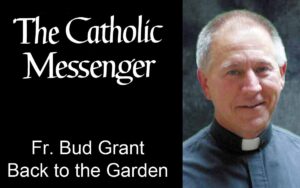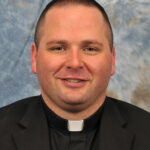By Father Bud Grant
We hear a lot about “sanctuary cities” these days. In Iowa we have 12 sanctuary counties plus Iowa City. But I’m stuck on the word “sanctuary.” Literally, it means a “holy place.” By common usage since the Middle Ages it has meant a church wherein fugitives could take refuge, immune to arrest. It was in that sense, I think, that Henry David Thoreau referred to the woods as his cathedral — it was certainly where he sought refuge from what he considered to be the corruption of “too much civilization.” Once, while living in Walden Woods, he wandered into town to get a shoe fixed and was promptly arrested for failing to pay a special levy to support the Mexican American War … a cause which revolted him. His consequent overnight incarceration resulted in the flash essay “Civil Disobedience,” which then echoed from Concord to St. Petersburg to Pietermaritzburg to Amritsar to Birmingham, truly the shot heard “round the world.” Incidentally, the Apostles practiced civil disobedience long before Thoreau, “rejoicing that they had been found worthy to suffer dishonor for the sake of the Name (Acts 5:27-32).
 Since Thoreau, numbers of writers have picked up on the theme that nature is a balm to the perceived corrosive effect of the city. “Wildness” became a romanticized font of healing and protection from the deleterious effects of urban life. John Muir preached that Gospel and made the great Yosemite Valley his sanctuary and ensured that it would remain one for all of us ever since.
Since Thoreau, numbers of writers have picked up on the theme that nature is a balm to the perceived corrosive effect of the city. “Wildness” became a romanticized font of healing and protection from the deleterious effects of urban life. John Muir preached that Gospel and made the great Yosemite Valley his sanctuary and ensured that it would remain one for all of us ever since.
I don’t really buy into the too binary notion that only nature is good and that cities are bad but, undeniably, we intuitively seek and find solace in green spaces. Ancient Rome had massive urban forests called “nemora” (glades/pastures). Colonial American villages had “commons,” practical parks used for grazing village milk cows. New York, the New Rome, has the massive “Central Park.” We Americans invented the National Park System and crowned it with Yellowstone which, with 6 million visitors a year, is now being “loved to death,” as Roderick Nash observes.
When I think of that delightful phrase “green sanctuary” (not my idea, though I wish it had been), I think of the earth itself. In the most literal sense it is our only refuge, our one safe place in space. It is also inherently sacred. St. Francis of Assisi sings of it as God’s glorious creation: “Be praised, my Lord, through our sister Mother Earth, who feeds us and rules us, and produces various fruits with colored flowers and herbs.” A gift for us, yet not to us because “To you alone, Most High, does it belong.”
Pierre Teilhard de Chardin, the Jesuit mystic Paleontologist, speaks of the “Cosmic Christ.” He means that the physical universe is the mystical body of Christ, an incarnation — a kind of Eucharist. On Easter, this year the day before Earth Day, we recall the resurrection of Christ from the tomb. It is a day of joy, hope and faith in the peculiarly scandalous idea that from suffering comes salvation. These two notions are easily intertwined. In “Laudato si,” Pope Francis speaks about: “the earthly Jesus and his tangible and loving relationship with the world … risen and glorious, present throughout creation by his universal Lordship” (100).
The earth is our singular sanctuary in this great cosmos. Yet it is suffering: scientists tell us that we can not heal her but only “mitigate” the damage and “adapt” to the new situation. It is not inevitable that we will save our relationship with our sister, Mother Earth. It will require a sort of crucifixion of our standard of living to see it again as our sacred God-given green sanctuary. “Our refuge, our strength, an ever-present help in distress … God is in its midst.” (Ps. 46:1-6.)
(Adapted from an Earth Day message, Holy Saturday, 2019.)
(Father Bud Grant is a professor of theology at St. Ambrose University in Davenport.)











